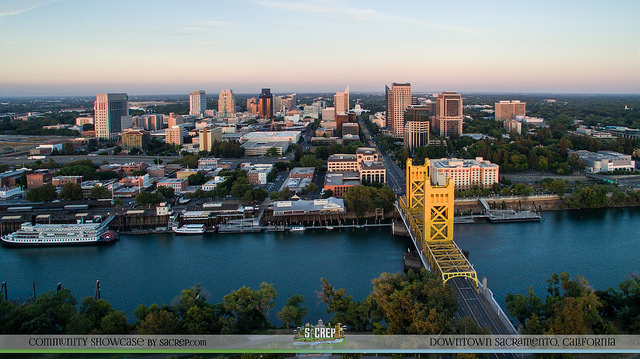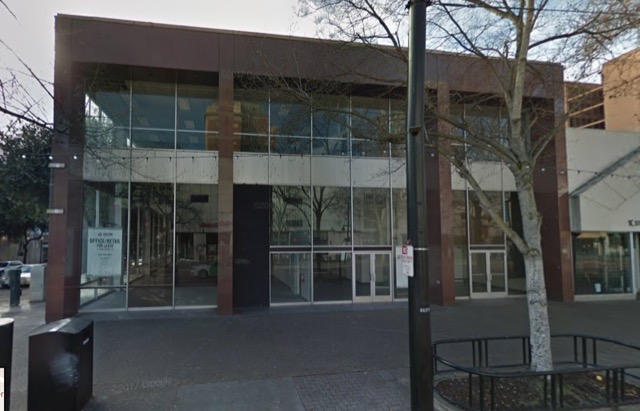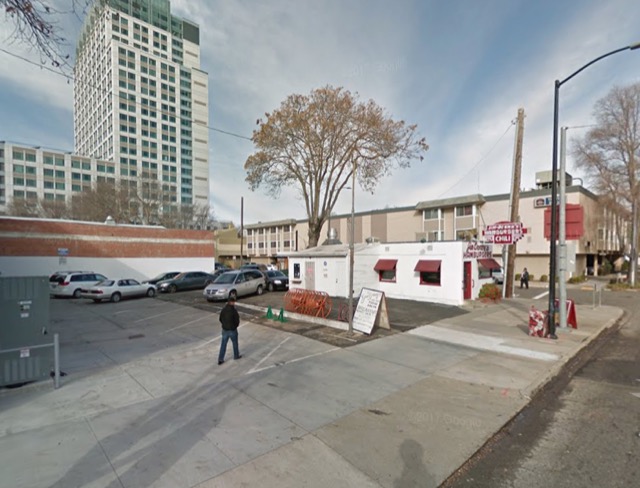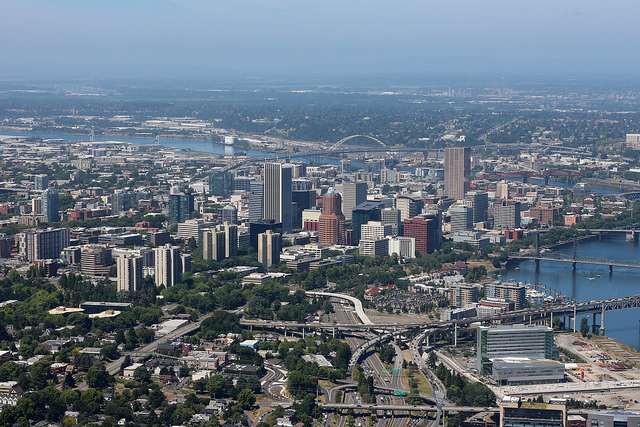If anywhere is a poster child for the effects of light rail on economic development, it is downtown Sacramento. Sacramento was one of the first American cities to build a modern light-rail line, opening its original 10-mile line in 1987 just a year after Portland’s. Since then it has extended that line and built two more, all of which go downtown, for a total system that is 45 miles long (compared with 60 miles in Portland).
Downtown Sacramento is mostly low-rise buildings with a few scattered high rises. Flickr photo by Sacramento Real Estate Photography.
As the capital of the nation’s most populous and possibly richest state, Sacramento is no small town. The urban area had 1.8 million people in 2015, slightly less than Portland and slightly more than San Jose. The city itself had half a million people, more than Atlanta, Miami, or Minneapolis.
Yet when I visited Sacramento a few weeks ago, the downtown area felt more appropriate for a urban area of 200,000, not close to 2 million. I decided I must not have seen the entire downtown. However, a recent column in the Sacramento Bee asks why a particular block in downtown is “the worst block” in the area.
Vacant retail/office building facing the light-rail line on K Street. Photo from Google maps.
As it happens, the block in question is just one block away from a light-rail line that, according to the propaganda, is supposed to generate economic development. The block in the article is 10th and J Street; as this map shows, the light rail goes down K street and has a stop between 10th and 11th. In fact, trains from all three light-rail lines use this particular segment of track. The Google street view photo of 10th and K shows a large, street-level retail/office space for lease. I don’t know if it is still vacant today, but if it isn’t, there are plenty of others that are, as there are numerous contenders for the title of “worst block in downtown.”
The column in the Bee blames the lack of development on J Street at least partly on the property owner. But my visit to downtown, during which I probably walked three miles or more, showed many vacant lots, vacant buildings, and dilapidated buildings in need of renewal.
viagra canada shipping Erectile dysfunction arises due to many reasons. If you have low thyroid function you will be levitra vs viagra put back to normal. 2. Any woman who experiences pain during intercourse should be buying viagra in uk examined by a gynecologist. In many cases, sexual dysfunction or lethargic sexual responses may cialis soft 20mg be caused by poor systemic health, stress, the build up of toxins and unhealthful lifestyles.
Jim-Denny’s may be a cute place, but if downtown Sacramento were thriving, it would have been replaced by more valuable developments long ago. Photo from Google maps.
Between trains on a Sunday morning, I was hungry and the only open restaurant was a place called Jim-Denny’s. It was a tiny hamburger stand dating to 1934 and virtually unchanged since then. While I don’t have any objection to the food, if downtown were thriving it would have been replaced by something else long ago. It occupied a small portion of a large lot, next to another vacant lot, across the street from more vacant lots, and around the block from other vacant lots. While eating pancakes, I saw several light-rail trains trundle by the front of the restaurant.
Downtown Portland is a solid mass of high rises. Flickr photo by Eric Prado.
While downtown Portland is a solid mass of high rises up to 40 stories tall, downtown Sacramento is mostly low rise with a few scattered high rises, the tallest of which is about 26 stories. There’s nothing wrong with that; high rises are the symbol of the cities of the early 1900s. But one of the claims for light rail is that it would rebuild downtowns to look like those early 1900 cities. It obviously hasn’t worked in Sacramento.
It didn’t work in Portland either, as most of its high rises, other than government buildings, were built before the light rail opened. The same is true for Seattle. Portland and Seattle have thriving downtowns because of microbrew pubs and restaurants, not light rail. Sacramento has microbrew pubs, but according to Google maps, only one, Rubicon Brewing, is located downtown, and it’s not on a light-rail line. A second downtown brew pub, the Brew It Up Brewery and Grill, is permanently closed.
Light rail has done little for downtown Sacramento. Anyone who visits Portland to see how light rail has supposedly stimulated economic development should make a side trip to Sacramento to get another view.












The Antiplanner wrote: Downtown Sacramento is mostly low-rise buildings with a few scattered high rises. Flickr photo by Sacramento Real Estate Photography.
Good, I’ve voiced my opinion that the skyscraper is a dying liability. The only places where highrise construction dominates isn’t just any city, it’s the older denser city, the grid city that was conceived before the advent of the automobile.
https://next3-assets.s3.amazonaws.com/activities/1031/backgrounds-1423866235-Grid_a1.png
Once a city is built to accommodate the automobile it loses it’s attractiveness to integrated dense urban development and the plan of the grid. Modern cities are not designed along those principles. High rises become largely plop art planted on a plaza, the plaza is a scrap thrown to civic leaders to accommodate shitty public art or give tourists reason to flock. William Whyte best summed it up in his documentary film “The Social Life of small urban spaces”.
And you don’t need highrises to be an exceptional cities.
http://images.complex.com/complex/image/upload/c_limit,w_680/fl_lossy,pg_1,q_auto/fnsnsklkqela70jqz0mz.jpg
People don’t realize the skyscraper is gonna be obsolete, they’re not built to accommodate the boom and bust cycles of real estate. This is best summed up in places like Dubai where highrise construction has broke record pace, I’ve seen them many of them are virtually empty. What do you expect when the heat where it costs as much as 1,000 a month just to air condition your condo and they’ve saturated the market with too many highrises. Burj Khalifa is half empty. rents in the Burj Khalifa plummeted 40% some ten months after its opening. Out of 900 apartments in the tower, 825 were still empty at that time. China is building whole cities for a populace that cant afford them, cause a third of their economy is state sponsored construction which is ridiculous even thou China has a billion people their population density is not high, prior to 2000 they were still very rural people. All this construction is resource use for resource use sake. For thousands of years the pyramids at Giza, Egypt were the tallest man made structure in the world; So I guess the Middle east is building glittering highrises to recapture that glory and to hopefully attract people to reassure them not to fear the hazards of radical Islam. And China is doing it cause to not to means sending millions of Chinese either back to the collectivist farms or the Nike factories.
Moral indignation is jealously with a halo. Good luck to them.
I sometimes lobby the state government in Sacramento. It appears much of the downtown businesses at least near the capitol building are oriented to government lobbyists, visitors, etc. then these businesses close at night. I asked one place why they closed at night and they said it wasn’t that safe after 6 pm with the potential for muggings.
I have a relative who lives in Sacramento and doesn’t ever go downtown. No reason to. So apparently the downtown is heavily dependent on government during regular business hours. Without more available parking it will be hard to make it into an evening and weekend entertainment center.
@LazyReader, thanks. Any comments on the house of Saud’s Kingdom tower?
@antiplanner, downtown Sacramento sounds like another state capital 25 years ago. The last person out of sleepy downtown St. Paul would shuts the lights out, usually around 5:30pm. It’s something now, not grand but nice. The changes were occuring before the Excel Center and the MN Wild. It was alive again long before they finished up the Central Corridor LRT line a couple years ago.
@prk166
Yes. As of May 2016, the building has reached the 47th floor and is expected to be completed in 2019.
But the services for this building are mind boggling, one capacity is that’ll require 156,000 cubic metres of treated and drinking water a day (40 million gallons for fire suppression, toilets, sinks, showers, water features and irrigation of nearly 8 acres of nearby landscaping). The estimated construction cost of US$1.23 billion, which is less than that of the Burj Khalifa (US$1.5 billion) which can be attributed to Saudi Arabia’s use of cheap labor and what practically amounts to what most liberals describe as slave labor. From a real estate perspective, it is considered virtually impossible to create enough demand to justify such a tower, but that at some point someone with a great excess of money will likely do it anyway.
Furthermore, economists have found large new skyscrapers to be a negative economic indicator, as these buildings often open on the verge of bad economy. Much of the study on this phenomenon was done in 1999 by Andrew Lawrence, a research director at Deutsche Bank who created the “skyscraper index,” originally as a joke. But later discovered a true phenomena that these towers open often during economic problems. Examples like
The Singer Building which opened during the Panic of 1907
40 Wall Street, the Chrysler Building and the Empire State Building built during the Great Depression
the World Trade Center and Sears Tower built during the 1970s economic flop
the Petronas Towers built during the Asian Crisis of the late 1990s
the Burj Khalifa built during the late-2000s recession.
Another phenomena I’ve observed is the abandonment effect where companies that often chose new highrises to headquarter or consolidate often leave in a few years for cheaper offices else where.
Singer Building (Singer sewing machine company) left for new offices
Sears Roebuck: occupied the Sears tower in 1974, left in 1991 for a cheaper low rise office campus in the suburbs.
Chrysler Building: Chrysler sold the holding in 1953
PanAm building, later MetLife building, sold in 2005, but the name remains.
Adding to the bubble-like feeling in the region, and the global economy in general, is the fact that Saudi Arabia, where the line is blurry between the regime’s money and the ruling family’s money, continues to move forward simultaneously with a myriad of new spending projects.
This is part of Saudi’s new ambitious construction boom. Much of this was due to the oil bubble. All this financing was put in place assuming $110/barrel of oil and a particular output level. That oil price can potentially get back up there, but only after significant production cuts. The total revenue will be unlikely to ever materialize, especially with the major oil consuming nations exploring domestic sources and showing year over year oil use decline for the past decade.
I would say Saudi Arabia is a lesson on attempting to maintain an economic system on a single commodity. If the Keystone XL pipeline is built oil will flow to the US south and if engineers ever successfully engineer a solution to extract shale oil (which the US has some of the largest global reserves at 3-6 Trillion barrels) oil prices will probably never rise above 80 ever again.
“Much of this was due to the oil bubble. All this financing was put in place assuming $110/barrel of oil and a particular output level…”
Venezuela nationalized the oil companies figuring easy money forever without knowing (or caring) how to run or maintain the oil fields and production. Now people are starving and it’s going to get a lot worse.
At least the Saudis know you have to keep the oil fields operational (However, it is fun to see them asking the US to slow down our oil companies – not going to happen until the next socialist gets elected).
LazyReader,
Your comments regarding skyscrapers is so true. Like new sports facilities and coincidentally most mass transit projects since the 1970’s, they are nothing more than civic jewelry. All three require a hub and spoke design to drive central core density for maximum utility.